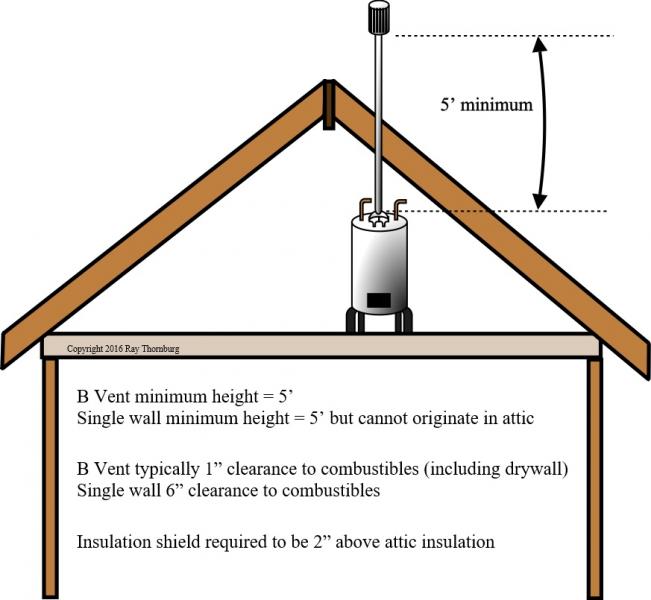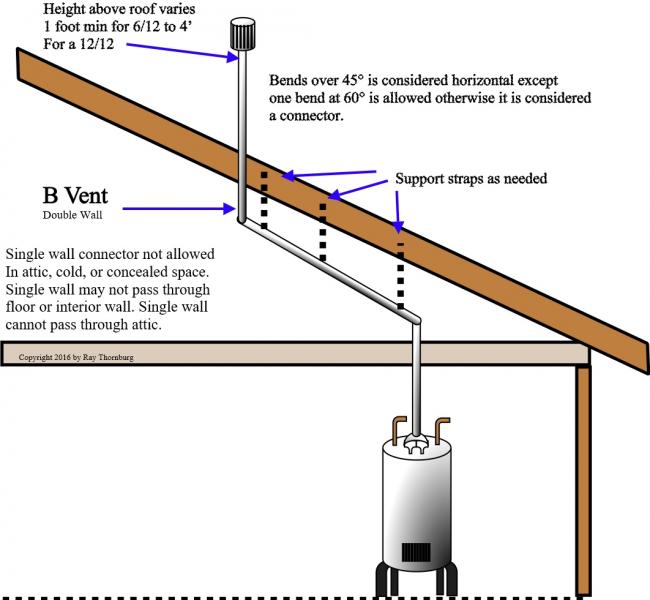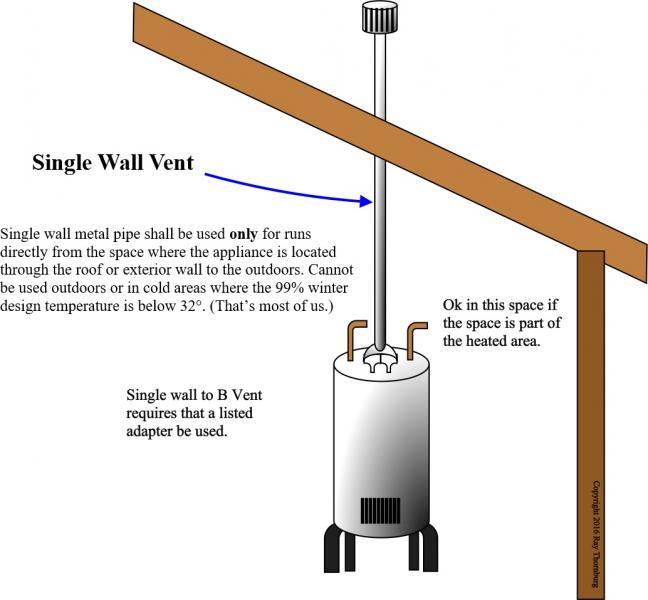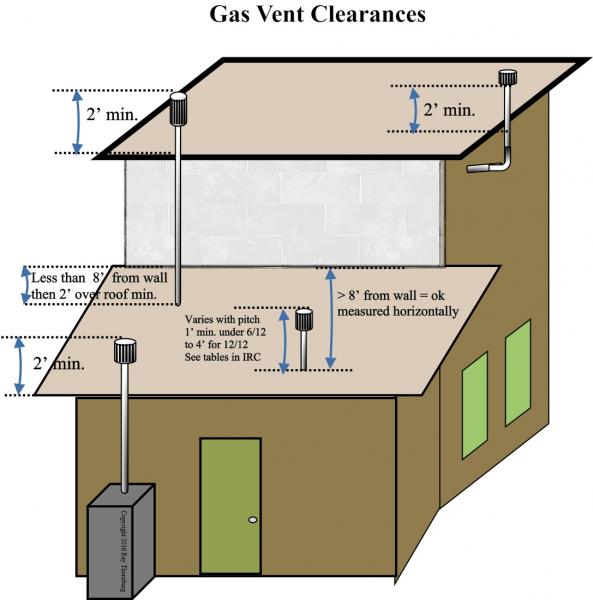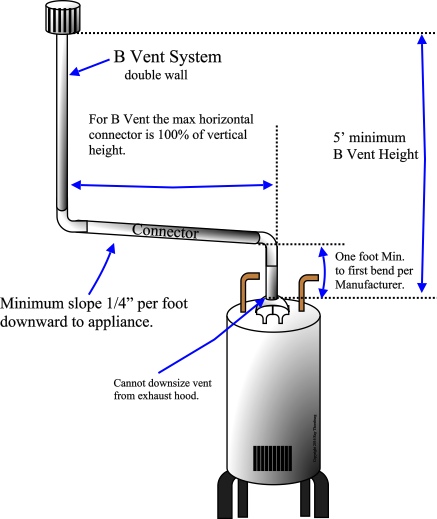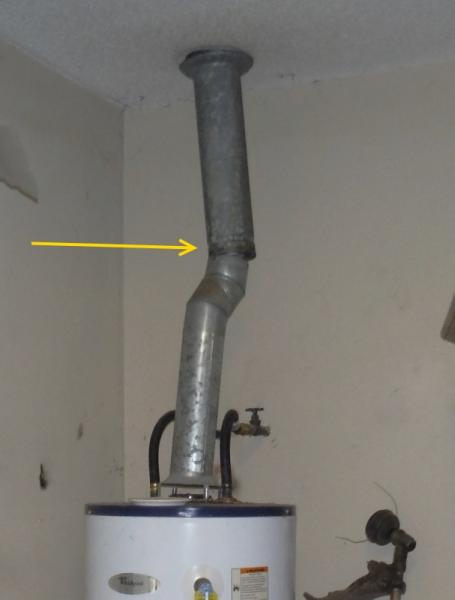- Home - Blue Palmetto Home Inspection of Summerville and Charleston
- Learn About Us and This Charleston Home Inspector
- What's Inspected
- Charleston Lowcountry Inspection Areas (geographic)
- Testimonials
- >>>Blogs (educational)
- Sample Reports & Documents
- Why Get a Home Inspection Report
- Charleston's Top Ten Reasons
- Home Inspector Photo Galleries
- Pricing
- Scheduling and Customer Information
- Home Inspection Authorization Contract
- General Scope of Work (electronic)
- Home Inspection Customer Satisfaction Survey
- Privacy Policy
- Full site
- The Roof Framers Field Manual
Charleston Home Inspector Discusses Gas Vents
Submitted by Ray Thornburg on Sun, 05/15/2016 - 19:24
What is a B- Vent?
A B vent is a double wall metal pipe used to vent gas appliances. There are other types of double walled vents too (like type L) but they are typically designed for other fuels.
Picture shows minimum B vent height above draft hood. Click image to enlarge into a new window.
About Natural Draft Venting for Gas Appliances
It's hard to begin a discussion of Gas Type B-Vents because it quickly starts to include an enormous plethora of other types of venting methods and it's easy to get confused. For our discussion we'll be talking only about naturally ventilated gas products like a water heater or air handler which uses normal atmospheric pressures to allow the exhaust gases to escape (category 1). It will not include direct vent, induced vent, mechanical draft, solid fuel, multiple appliances or fuel oil type of appliances. Some of these other types of products have less restrictive venting procedures and often the instructions for venting is listed on the product itself (like a tankless water heater). Some of them will have a chimney which more resembles a part of the drainage system than a exhaust vent (like PVC). They all require their own special procedures. Also we will not discuss sizing of vent systems.
What is a B-Vent?
A B-Vent is a metal flue gas exhaust vent with a double wall type of construction. The inner wall conveys the flue gases out of the building while the double wall helps flue gases warm enough to properly exit the home and reduces clearance requirements to combustibles. A flue pipe which is too cool will allow condensation to develop where it can combine with flue gases to form a type of acid. This can deteriorate the pipe thus allowing flue gases into the home. So there's a lot of science involved in this. B-vents twist and lock together so screws are not used except at the draft hood or if it connects with a single wall pipe. In most cases manufacturers require that a single wall to double wall adapter be used at the transition point.
Vent or Connector?
One of the confusing terms used by code writers is the use of the word vent and the word vent connector. The vent is the final vertical part of the system while the vent connector describes the parts that connect to it as long as it is below a 45° angle (one 60° angle allowed). So if a pipe goes straight up from the draft hood the whole thing is the vent. If the final vertical vent pipe is not directly above the appliance and a transition piece is used to connect it then that piece is called a vent connector. This is important because the rules for vents and vent connectors are different. For instance a vent connector cannot be located in concealed locations and typically do not pass through floors, attics, walls, ceilings and roofs (except listed components like B Vent).
Picture at left shows B-Vent with the one allowable 60 degree turn. Click image to enlarge
At left is one way a single wall vent pipe can be used...and it's limitations.
Single Wall
Before we begin our discussion of double wall B vents let's talk about when it's ok to use a single wall vent pipe. While it is considered poor practice to mix single wall and double wall components together there are times when it is necessary and allowed if done properly. Lets take a look at some rules:
Not used outdoors if 99% winter design temp is below 32° (that's us).
Shall terminate at least 5' above draft hood vertically.
Must use approved cap.
Only use (single wall) from the appliance directly to outside through wall or roof without interruption. Cannot pass through attic, floor space, concealed space, inside wall. Cannot originate in any concealed space or attic.
Six inch clearance to combustibles.
Single wall must connect to double wall before the ceiling and be connected with 3 screws. Manufacturers require a listed transition piece be used to transition from single wall to double wall.
Typical gas B-Vent roof clearances shown.
Double Wall B Vent
Now Lets take a look at some rules for double wall pipe.
Install per manufacturers instructions and listing.
Minimum height is 5 foot from vent hood to cap.(except wall furnace 12')
Insulation shield 2” above the insulation made of sheet metal.
Natural and Mechanical draft systems cannot be connected together.
Vents cannot pass through air ducts or plenums.
Roof thimble shall be listed for use with B vents. (no rubber pipe flashings)
Screws cannot penetrate the inner wall except at draft hood, flue collar, or a single wall to double wall connector.
Shall be properly supported.
B vent minimum 1” to combustibles.
One foot minimum to first offset over draft hood. (per manufacturers instructions Duravent Brand)
Max vent size is 7x diameter of draft hood.
Never downsize vent.
Vent should match draft hood or a suitable transition coupling be used.
No solid fuel and gas in the same vent.
Unused openings need to be closed off.
B Vent cap cannot terminate horizontally.
No tape of any kind allowed.
Never vent to an unlined masonry chimney even if they are tile lined. Use listed liners or B vents.
Cannot be installed at the extreme bottom of a masonry chimney.
Connector
A vent connector shall have a minimum slope of 1/4” per foot upward with no sags.
Connector cannot be greater than 2 sizes larger than flue collar.
One 60° offset, others max 45° offset. Angle greater than 45 is considered horizontal.
Horizontal (connector) distance of vent cannot exceed 75% of total height (100% for double wall) or 1.5 feet for every inch of diameter of pipe. (ex 4” pipe = 6').
Route connectors as short as possible. Use two 45's instead of two 90° elbows for instance for less reduction in capacity if possible.
B-Vent with connector requirements shown.
The above information was gathered using different manufacturers instructions and the IRC 2012 : 2426,2427 as a guide and is for your information only. Please verify local requirements or have a professional install your products as all product requirements are different. So read the instructions for your particular product or have your installer read them.
Now Let's take a look at what we find out in the field.
A missing cap is a deficiency. Only a listed cap should be used. Home made caps are not allowed. Picture taken in Charleston SC.
A rubber boot like this is not allowed. Must use a metal one. This one is cracked and leaking.
Here is an example of B vent being used as a horizontal vent connector. There are several problems here, lack of support, dips and sags, improper slope (must slope upwards at least 1/4" per foot) and it is too long for the height of the vent. Picture taken in St. George SC.
Here is one that was just kind of hanging there. There should be a listed transition piece at the junction (required by manufacturers); so it came loose. Although we often see this; the single wall is not really allowed in unheated areas. Carbon monoxide is a real concern if a B vent is not properly installed. Picture taken in Summerville SC.
Here is an example of improper clearance to the side wall. Minimum side wall clearance is 8 foot. It's easy to understand the possibility of melting the siding when it is so close to the wall. It's harder to understand why in a case like this that it has to be moved so far (8'); but it is thought that sidewall air turbulence can change the air pressure and thus upset the draft in the pipe.
These outdoor water heater closets are never in great condition it seems. In this case the vent fails to meet the minimum 5 foot height and is required to extend above the roof which is right above the window in this case. Of course you never want a vent of any sort near an operable window. One of the most common issues we find with these outdoor water heater closets is lack of a suitable floor which keeps the water heater up and out of the mud. They are frequently rusty on top and not sealed well to the vent.
On this Charleston home the vent was not secure to the vent hood thus allowing deadly carbon monoxide to enter into the attic area. Three screws are required. Believe this or not this is actually not that uncommon. A condition like this could go unnoticed for a long time because it was in the attic. Good thing though....had it been in the home the occupants would be dead. It pays to get a home inspection.
This single wall vent on a Summerville home requires a 6" clearance to combustibles. Really though it should be a double wall B vent. Single wall is not allowed in unheated areas and not allowed to transition in the attic. The reason for this rule is to prevent condensation from forming on the pipe. Condensation combines with flue gasses to form a type of acid which will deteriorate the pipe over time. This in turn could allow leakage of deadly carbon monoxide gas.
Often when we find a deficiency in a vent system there are multiple issues involved so it is important to get a qualified professional make it right. When it comes to exhaust gases a mistake could be deadly.

